欢迎来到数据分析的世界
博客主页:卿云阁欢迎关注点赞收藏⭐️留言
本文由卿云阁原创!
首发时间:2025年9月30日
✉️希望可以和大家一起完成进阶之路!
作者水平很有限,如果发现错误,请留言轰炸哦!万分感谢!
目录
简单介绍
Matplotlib2个简单的例子
Matplotlib细节介绍
线条样式
线条颜色
标记(marker)
Seaborn绘图基本步骤与示例
Seaborn核心绘图函数与方法
关联图
散点图
线形图
API 层级:Axes-level 和 Figure-level
类别图
散点图 strip / swarm
箱线图 box
增强箱线图 boxen
小提琴图 violin
点线图 point
条形图 bar
计数条形图 count
分布图
单变量分布图 distplot
编辑
核密度估计图 kdeplot
二元变量分布图 jointplot
变量两两对比图 pairplot
回归图
regplot
lmplot
矩阵图
热力图 heatmap
层次聚类结构图clustermap

简单介绍
它是 Python 的 “万能绘图工具”—— 能把 Excel、Pandas 里的数字,变成折线图、柱状图、
散点图等直观图形,小到临时看数据趋势,大到学术论文配图,都能搞定。(配一张 “Matplotlib
在 Python 数据生态中的位置图”:NumPy/Pandas(处理数据)→ Matplotlib(绘图)→
Seaborn(美化),用箭头体现依赖关系)。

Seaborn 是基于 Matplotlib 开发的 Python 可视化库,核心优势是用更简洁的代码,画出更美
观、更具统计意义的图表。很多人会问:“已经会用 Matplotlib 了,为什么还要学 Seaborn?” 看这
组对比就懂了:


Matplotlib2个简单的例子
第一个例子
流程:
1️⃣准备数据 ➡ 2️⃣创建画布 ➡ 3️⃣绘制图像 ➡ 4️⃣添加细节(标题、x轴/y轴标签、坐标轴
范围、网格线,图例) ➡ 5️⃣调整布局 ➡ 6️⃣保存图片 ➡ 7️⃣图片展示
# 导入Matplotlib绘图模块,约定简写为plt
import matplotlib.pyplot as plt
# 设置中文字体,解决负号显示乱码问题
plt.rcParams["font.family"] = ["SimHei"]
plt.rcParams['axes.unicode_minus'] = False
# 准备散点图数据:身高(x轴)与体重(y轴),数据长度需一致
height = [160, 165, 170, 175, 180] # 身高(cm)
weight = [50, 55, 62, 68, 75] # 对应体重(kg)
# 创建画布,尺寸6×4英寸(1英寸≈2.54cm),设置分辨率为100
plt.figure(figsize=(6, 4), dpi=100)
# 绘制散点图:橙色(#FF9F43)、大小80、透明度0.8,添加边框
plt.scatter(height, weight,color='#FF9F43',s=80,alpha=0.8,label='学生数据',edgecolors='#E67E22', # 散点边框颜色linewidth=1) # 散点边框宽度
# 添加图表标题、x轴/y轴标签,优化字体样式
plt.title('身高与体重关系', fontsize=14, pad=15, fontweight='bold')
plt.xlabel('身高(cm)', fontsize=12, labelpad=8)
plt.ylabel('体重(kg)', fontsize=12, labelpad=8)
# 优化坐标轴范围,使数据点更居中
plt.xlim(155, 185)
plt.ylim(45, 80)
# 添加浅灰色网格线(透明度0.3),辅助读数据
plt.grid(alpha=0.3, linestyle='--') # 使用虚线网格
# 在右上角显示半透明边框的图例,优化图例文字大小
plt.legend(loc='upper right', framealpha=0.1, fontsize=10)
# 调整布局,避免元素重叠
plt.tight_layout()
# 保存图片(高分辨率,裁剪空白)
#plt.savefig('height_weight.png', dpi=300, bbox_inches='tight')
# 弹出窗口展示图表
plt.show()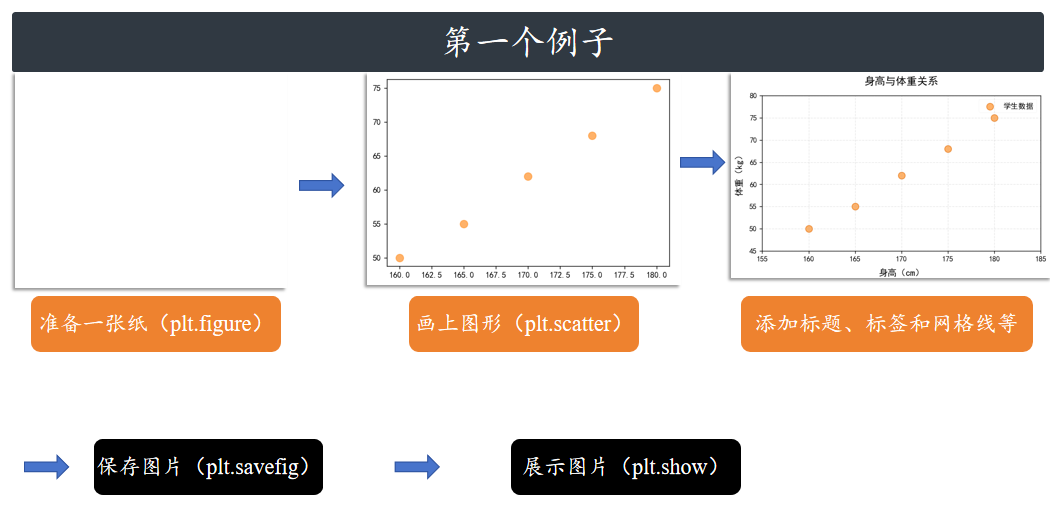
第二个例子
流程:
1️⃣准备数据 ➡ 2️⃣创建画布 ➖ 定义子图 ➡ 3️⃣绘制图像 ➡ 4️⃣添加细节(标题、x轴/y
轴标签、坐标轴范围、网格线,图例) ➡ 5️⃣调整布局 ➡ 6️⃣保存图片 ➡ 7️⃣图片展示
import matplotlib.pyplot as plt
# 设置中文字体,确保中文正常显示
plt.rcParams["font.family"] = ["SimHei"]
plt.rcParams['axes.unicode_minus'] = False # 解决负号显示问题
# Step 1: 准备数据
x = [1, 2, 3, 4]
y = [10, 20, 25, 30]
scatter_x = [2, 4, 6]
scatter_y = [5, 15, 25]
# Step 2: 创建图形(画布)
fig = plt.figure(figsize=(12, 5)) # 加宽画布以容纳两个子图
# Step 3: 使用add_subplot定义子图(1行2列布局)
ax1 = fig.add_subplot(121) # 1行2列的第1个子图(左侧)
ax2 = fig.add_subplot(122) # 1行2列的第2个子图(右侧)
# 第一个子图:绘制折线图
ax1.plot(x, y, color='lightblue', linewidth=3, label='折线图')
ax1.set_xlim(1, 6.5)
ax1.set_ylim(0, 35)
ax1.set_xlabel('X轴')
ax1.set_ylabel('Y轴')
ax1.set_title('折线图示例')
ax1.legend()
ax1.grid(alpha=0.3)
# 第二个子图:绘制散点图
ax2.scatter(scatter_x, scatter_y, color='darkgreen', marker='^', label='散点图')
ax2.set_xlim(1, 6.5) # 保持x轴范围一致
ax2.set_ylim(0, 35) # 保持y轴范围一致
ax2.set_xlabel('X轴')
ax2.set_ylabel('Y轴')
ax2.set_title('散点图示例')
ax2.legend()
ax2.grid(alpha=0.3)
# 调整布局,避免标签重叠
plt.tight_layout()
# 保存图形(可选), transparent=True 透明画布
# plt.savefig('add_subplot_example.png', dpi=300, bbox_inches='tight')
# 显示图形
plt.show()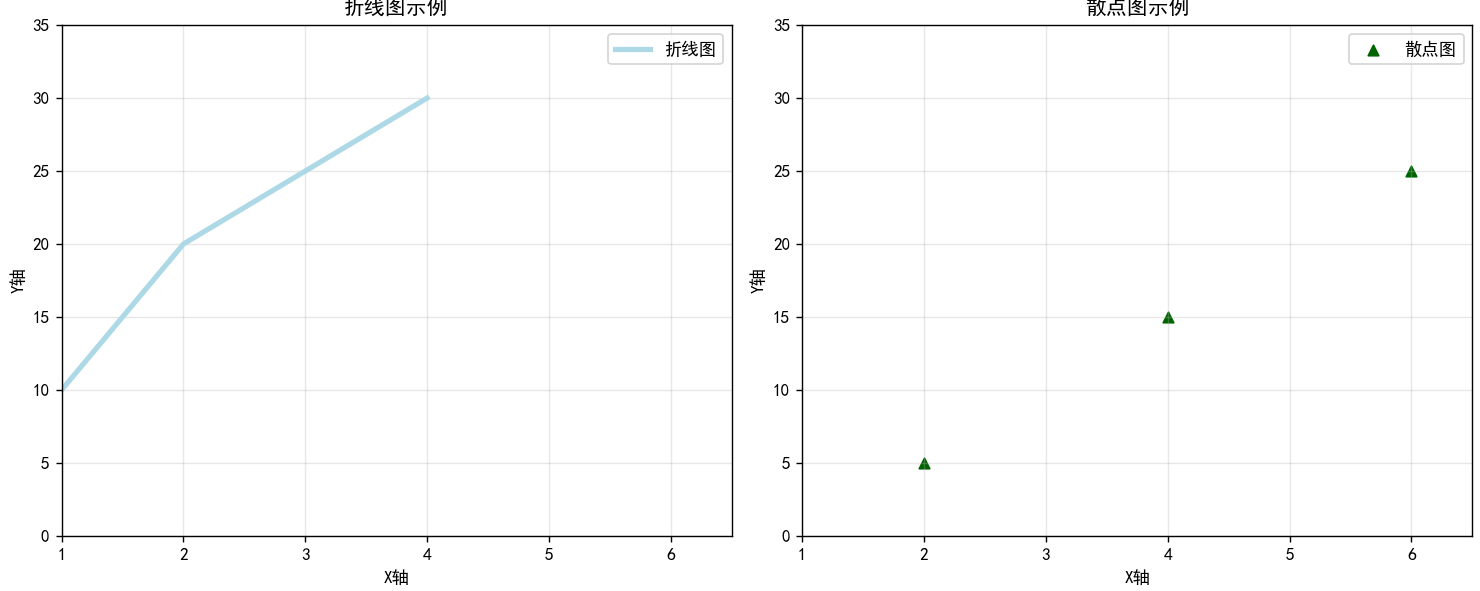
Matplotlib细节介绍
线条样式
核心作用是区分不同数据系列(比如用实线表示 “实际销量”,虚线表示 “预测销量”)

import matplotlib.pyplot as plt
import numpy as np
# 中文设置
plt.rcParams["font.family"] = ["SimHei"]
plt.rcParams['axes.unicode_minus'] = False
# 数据:x为0-10的连续值,y1-y4为不同数据系列
x = np.linspace(0, 10, 50)
y1 = x # 实线(默认)
y2 = x + 1 # 虚线
y3 = x + 2 # 点线
y4 = x + 3 # 点划线
# 创建画布和子图
fig, ax = plt.subplots(figsize=(8, 5))
# 绘制4条不同样式的线,标注清晰
ax.plot(x, y1, linestyle='-', linewidth=2, label='实线(默认,solid)')
ax.plot(x, y2, linestyle='--', linewidth=2, label='虚线(dashed)')
ax.plot(x, y3, linestyle=':', linewidth=2, label='点线(dotted)')
ax.plot(x, y4, linestyle='-.', linewidth=2, label='点划线(dashdot)')
# 装饰:让图表更易读
ax.set_title('不同线条样式对比', fontsize=14)
ax.set_xlabel('X轴', fontsize=12)
ax.set_ylabel('Y轴', fontsize=12)
ax.legend() # 显示图例,对应线条样式
ax.grid(linestyle=':', alpha=0.3) # 网格线用点线,避免干扰主线条
plt.show()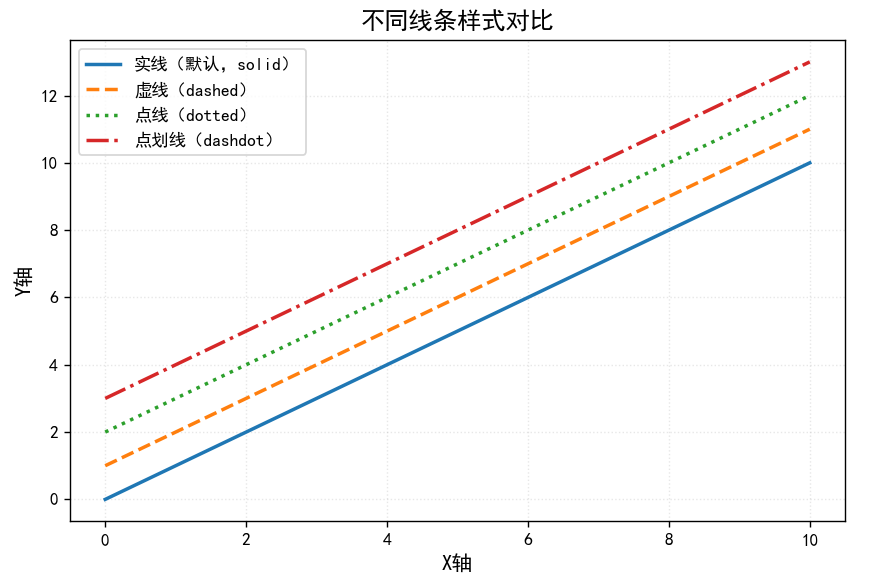
线条颜色
方式 1:预设色名
Matplotlib 支持 140 + 预设色名(如 'red'、'blue'),涵盖常见颜色,直接输入名称即可使用,
适合快速绘图。
方式 2:缩写色码(快速输入)
将常用颜色缩写为单个字母,适合高效写代码,仅支持 8 种基础颜色:
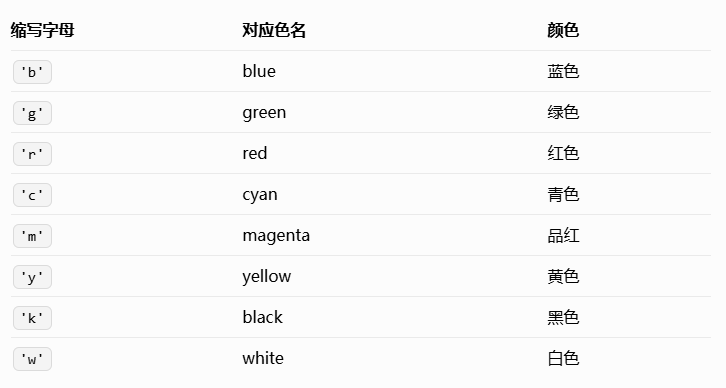
方式 3:十六进制色码(精准控色)
通过 '#RRGGBB' 格式设置颜色(RR、GG、BB 分别代表红、绿、蓝通道,取值 00-FF),可从设
计工具(如 PS、Figma)或配色网站(如Coolors)获取,适合需要统一图表配色风格的场景(如
公司品牌色)。示例:'#FF6B6B'(珊瑚红)、'#4ECDC4'(薄荷绿)、'#45B7D1'(天空蓝)
方式 4:RGB/RGBA 色值(透明度可控)
通过 (R, G, B) 或 (R, G, B, A) 元组设置颜色,其中 R、G、B 取值范围为 0-1(表示颜色强
度),A 为透明度(0 = 完全透明,1 = 完全不透明),适合需要精细调整透明度的场景(如重叠
线条)。示例:(1, 0, 0)(纯红)、(0, 0.8, 0, 0.5)(半透明绿)
import matplotlib.pyplot as plt
import numpy as np
# 中文设置
plt.rcParams["font.family"] = ["SimHei"]
plt.rcParams['axes.unicode_minus'] = False
# 数据:x为0-10,y为x的不同偏移
x = np.linspace(0, 10, 50)
y1 = x # 预设色名
y2 = x + 1 # 缩写色码
y3 = x + 2 # 十六进制色码
y4 = x + 3 # RGBA色值
# 创建画布
fig, ax = plt.subplots(figsize=(8, 5))
# 4种颜色设置方式
ax.plot(x, y1, color='orange', linewidth=3, label='预设色名(orange)')
ax.plot(x, y2, color='r', linewidth=3, label='缩写色码(r=red)')
ax.plot(x, y3, color='#4ECDC4', linewidth=3, label='十六进制(#4ECDC4=薄荷绿)')
ax.plot(x, y4, color=(0, 0.6, 0.8, 0.7), linewidth=3, label='RGBA(半透明蓝,A=0.7)')
# 装饰
ax.set_title('4种颜色设置方式对比', fontsize=14)
ax.set_xlabel('X轴', fontsize=12)
ax.set_ylabel('Y轴', fontsize=12)
ax.legend()
ax.grid(alpha=0.3)
plt.show()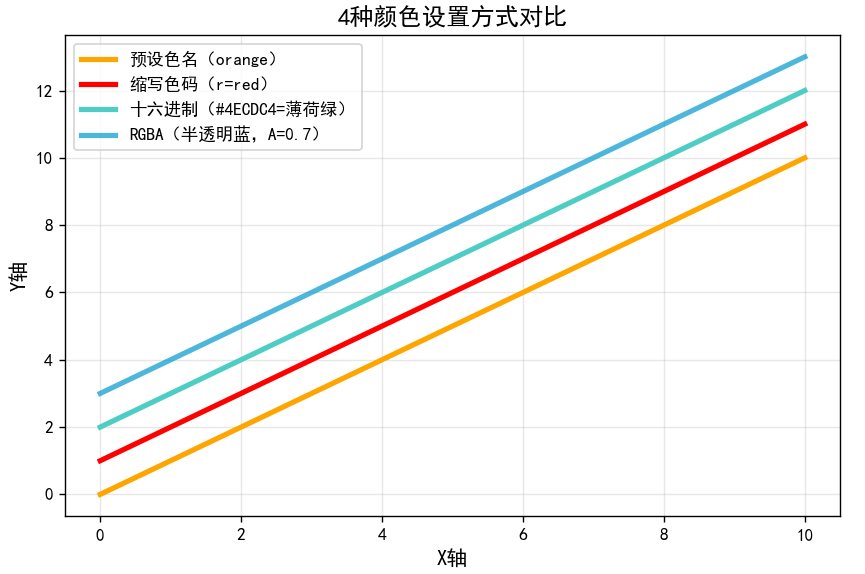
标记(marker)
标记是折线图中 “数据点的符号”,核心作用是突出实际数据位置(比如用圆形标记 “每日销量”
的具体数值,避免读者只能看到线条趋势而找不到原始数据)。
通过 marker 参数设置标记样式,markersize(简写 ms)设置标记大小,markeredgecolor(简
写 mec)设置标记边框颜色,markerfacecolor(简写 mfc)设置标记填充颜色
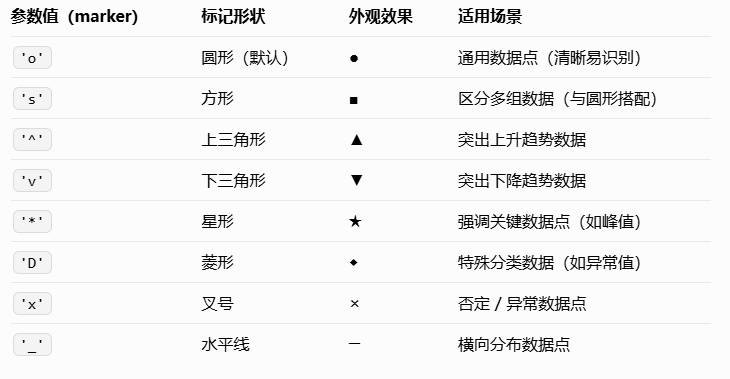
import matplotlib.pyplot as plt
import numpy as np
# 中文设置
plt.rcParams["font.family"] = ["SimHei"]
plt.rcParams['axes.unicode_minus'] = False
# 数据:模拟5个时间点的销量(离散数据,适合加标记)
x = [1, 2, 3, 4, 5] # 天数
y = [120, 180, 150, 220, 190] # 销量
# 创建画布
fig, ax = plt.subplots(figsize=(8, 5))
# 绘制带标记的折线:自定义标记样式、大小、颜色
ax.plot(x, y,linewidth=2, # 线条粗细color='#FF6B6B', # 线条颜色(珊瑚红)marker='o', # 标记为圆形markersize=8, # 标记大小markeredgecolor='white', # 标记边框为白色(突出立体感)markerfacecolor='#45B7D1', # 标记填充色(天空蓝)label='每日销量')
# 进阶:给标记添加数值标签(让数据更直观)
for i in range(len(x)):ax.text(x[i], y[i] + 5, # 标签位置(在标记上方5个单位)str(y[i]), # 标签内容(销量数值)ha='center', va='bottom', # 水平/垂直居中fontsize=10, color='black')
# 装饰
ax.set_title('标记样式自定义与数值标注', fontsize=14)
ax.set_xlabel('天数', fontsize=12)
ax.set_ylabel('销量(件)', fontsize=12)
ax.set_ylim(100, 240) # 调整y轴范围,避免数值标签超出
ax.legend()
ax.grid(alpha=0.3)
plt.show()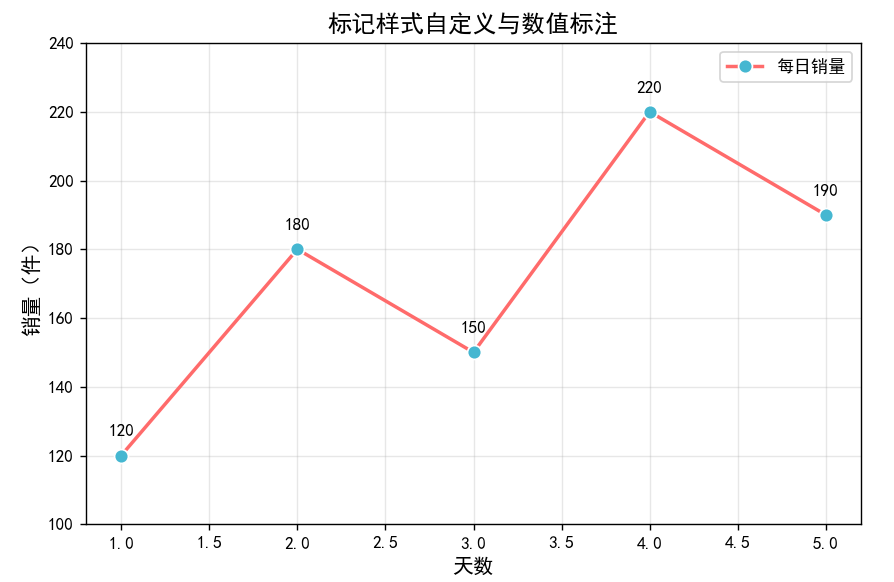
组合实战:用 “样式 + 颜色 + 标记” 画专业图表
实际绘图中,三者通常结合使用,以下以 “对比‘实际销量’与‘预测销量’” 为例,展示如何通过组
合设置让图表清晰、专业:
import matplotlib.pyplot as plt
import numpy as np
# 中文设置
plt.rcParams["font.family"] = ["SimHei"]
plt.rcParams['axes.unicode_minus'] = False
# 数据:实际销量(离散) vs 预测销量(连续)
x_actual = [1, 2, 3, 4, 5, 6, 7] # 一周7天(实际数据)
y_actual = [120, 180, 150, 220, 190, 250, 230]
x_pred = np.linspace(0.5, 7.5, 50) # 连续x值(预测曲线)
y_pred = 100 + 20 * x_pred # 预测销量(线性拟合)
# 创建画布
fig, ax = plt.subplots(figsize=(10, 6))
# 1. 绘制实际销量:突出数据点(大标记+实线条)
ax.plot(x_actual, y_actual,color='#FF6B6B', linewidth=3, linestyle='-',marker='o', markersize=10, markeredgecolor='white', markerfacecolor='#FF6B6B',label='实际销量')
# 2. 绘制预测销量:辅助线条(无标记+虚线条)
ax.plot(x_pred, y_pred,color='#45B7D1', linewidth=2, linestyle='--',marker='None', # 无标记(预测是连续曲线,无需数据点)label='预测销量(线性拟合)')
# 3. 标注关键数据点(如最高销量)
max_idx = y_actual.index(max(y_actual)) # 找到最高销量的索引
ax.annotate(f'最高销量:{y_actual[max_idx]}件', # 标注内容xy=(x_actual[max_idx], y_actual[max_idx]), # 标注目标点xytext=(x_actual[max_idx]+0.5, y_actual[max_idx]+20), # 标注文字位置arrowprops=dict(arrowstyle='->', color='gray'), # 箭头样式fontsize=11, color='darkred')
# 装饰
ax.set_title('一周销量:实际 vs 预测', fontsize=16, pad=20)
ax.set_xlabel('天数', fontsize=12)
ax.set_ylabel('销量(件)', fontsize=12)
ax.set_xlim(0.5, 7.5)
ax.set_ylim(80, 300)
ax.legend(loc='best',fontsize=11)
ax.grid(linestyle=':', alpha=0.3)
# 保存高清图片(适合报告/论文)
#plt.savefig('销量对比图.png', dpi=300, bbox_inches='tight')
plt.show()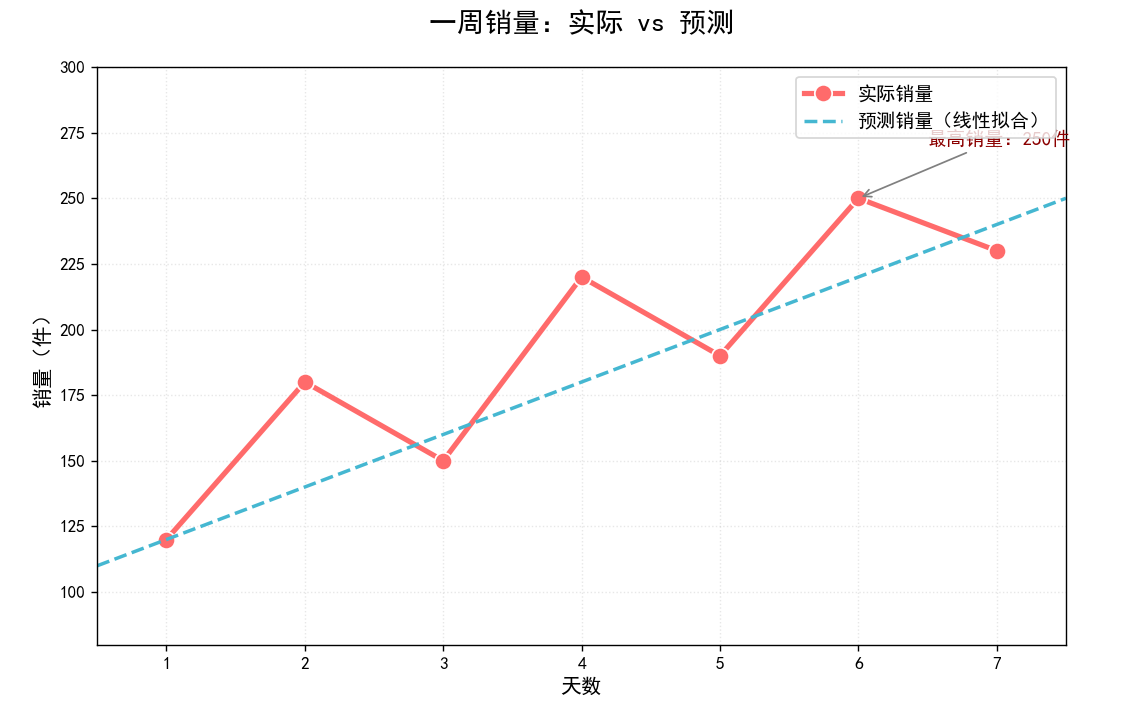
Seaborn绘图基本步骤与示例
使用 Seaborn 创建图形的基本步骤:
- Step 1 准备数据
- Step 2 设定画布外观
- Step 3 使用 Seaborn 绘图
- Step 4 自定义图形
- Step 5 展示结果图
# 导入Matplotlib的pyplot模块(用于基础绘图和显示图表)
import matplotlib.pyplot as plt
# 导入Seaborn库(用于绘制更美观的统计图表,基于Matplotlib)
import seaborn as sns
# 导入 warnings 模块(用于控制警告信息的显示)
import warnings
# 忽略所有警告信息(避免因版本兼容等问题输出冗余警告,不影响代码功能)
warnings.filterwarnings('ignore')
# Step 1:加载Seaborn内置的"小费数据集"
# 该数据集包含餐厅消费金额、小费、顾客性别、用餐时间等信息
tips = sns.load_dataset("tips")
# Step 2:设置Seaborn的图表主题
# "whitegrid"表示白色背景+灰色网格线(适合大多数场景,清晰且不干扰数据)
sns.set_style("whitegrid")
# Step 3:绘制带回归线的散点图(lmplot = linear model plot,线性模型图)
# 参数解析:
# - x="tip":x轴数据为"小费金额"(数据集的列名)
# - y="total_bill":y轴数据为"总账单金额"(数据集的列名)
# - data=tips:使用的数据集(之前加载的tips)
# - aspect=2:图表的宽高比(宽度是高度的2倍,让图表更舒展)
# 返回值g是一个FacetGrid对象(用于后续调整图表细节)
g = sns.lmplot(x="tip", y="total_bill", data=tips, aspect=2)
# 对返回的图表对象g进行细节调整:
# - set_axis_labels("Tip", "Total bill(USD)"):设置x轴和y轴的标签文本
# - set(xlim=(0, 10), ylim=(0, 100)):设置x轴范围为0-10,y轴范围为0-100
g = (g.set_axis_labels("Tip", "Total bill(USD)").set(xlim=(0, 10), ylim=(0, 100)))
# Step 4:添加图表标题(使用Matplotlib的plt.title()函数,Seaborn兼容Matplotlib的操作)
plt.title("title") # 实际使用时可替换为有意义的标题,如"小费金额与总账单的关系"
# Step 5:显示图表(虽然传入了g,但plt.show()可以直接显示当前画布内容,参数可省略)
plt.show(g)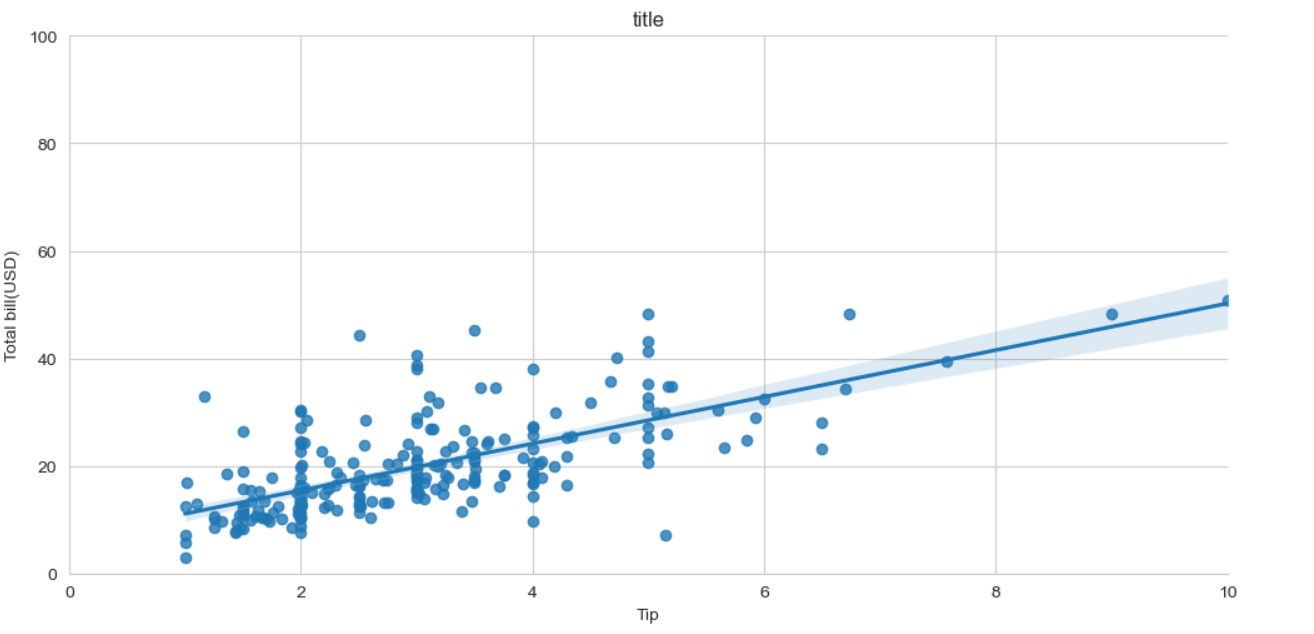
图标样式
# 设置Seaborn全局图表样式,所有后续绘制的图表会默认遵循这些配置
sns.set_theme(context='notebook', # 控制图表元素(字体、线条)的整体大小# context可选值:'paper'(最小,适合论文)、'notebook'(中等,默认,适合笔记本)# 'talk'(较大,适合幻灯片)、'poster'(最大,适合海报)style='whitegrid', # 定义图表基础风格(背景、网格线等)# style可选值:'whitegrid'(白背景+灰网格,默认)、'darkgrid'(深灰背景+白网格)# 'white'(纯白背景,无网格)、'dark'(纯深灰背景,无网格)palette='Set2', # 设置全局默认配色方案,控制不同类别数据的颜色# palette常用值:'Set2'(柔和对比色)、'Pastel1'(马卡龙色系)# 'husl'(高饱和均匀色)、'coolwarm'(冷暖渐变)、'viridis'(色盲友好渐变)font='sans-serif', # 指定图表中所有文本的字体类型# font可选值:'sans-serif'(无衬线字体,如Arial,默认,易读)# 'serif'(衬线字体,如Times New Roman,适合论文)# 'monospace'(等宽字体,如Courier,适合代码)# 中文支持可改为:'SimHei'、'WenQuanYi Micro Hei'(需系统安装)font_scale=1, # 文本大小缩放比例(基于context的基准尺寸)# 例:font_scale=1.2(放大20%)、font_scale=0.8(缩小20%)color_codes=False # 是否启用颜色代码缩写(如'b'代表蓝色)# True:允许简写(如color='b');False(默认):需写完整名称(如color='blue')
)Seaborn核心绘图函数与方法
- 关联图——relplot
- 类别图——catplot
- 分布图——distplot、kdeplot、jointplot、pairplot
- 回归图——regplot、lmplot
- 矩阵图——heatmap、clustermap
- 组合图
导入数据集:
下面我们会使用 iris 鸢尾花数据集完成后续的绘图
数据集总共 150 行,由 5 列组成。分别代表:萼片长度、萼片宽度、花瓣长度、花瓣宽度、
花的类别。其中,前四列均为数值型数据,最后一列花的分类为三种,分别是:Iris Setosa、Iris
Versicolour、Iris Virginica。

关联图
当我们需要对数据进行关联性分析时,可能会用到 Seaborn 提供的以下几个 API。
| API层级 | 关联性分析 | 介绍 |
|---|---|---|
| Figure-level | relplot | 绘制关系图 |
| Axes-level | scatterplot | 多维度分析散点图 |
| lineplot | 多维度分析线形图 |
relplot 是 relational plots 的缩写,用于呈现数据之后的关系。relplot 主要有散点图和线形图2种
样式,适用于不同类型的数据。
散点图
指定x和y的特征,默认可以绘制出散点图。
sns.relplot(x="sepal_length", y="sepal_width", hue="species", style="species", data=iris)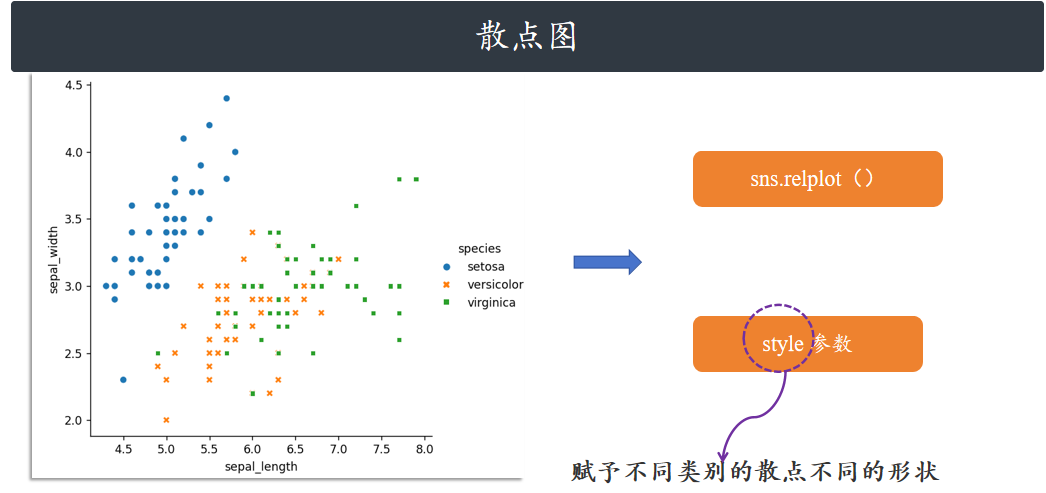
线形图
relplot 方法还支持线形图,此时只需要指定 kind=”line” 参数即可。图中阴影部分是自动给出的
95%的置信区间。(如果我们重复做 100 次相同的实验 / 数据采集,会得到 100 组 “花萼长度 - 花
瓣长度” 的趋势线,其中有 95 条线会落在这个浅色阴影范围内。换个更直白的说法:我们基于当
前的鸢尾花数据集(150 个样本),计算出 “花瓣长度随花萼长度变化的趋势线”(图中的彩色实
线),但这个趋势线只是 “基于现有样本的估计值”—— 如果换一批新的鸢尾花样本(同样 150
个),重新画趋势线,线的位置可能会轻微偏移。而 95% 置信区间就是告诉我们:新趋势线 “大
概率(95% 的概率)” 会落在的范围,阴影越窄,说明这个趋势的 “稳定性越强”。)
阴影越窄→趋势越稳定,阴影越宽→趋势的不确定性越高
sns.relplot(x="sepal_length", y="petal_length", hue="species", style="species", kind="line", data=iris)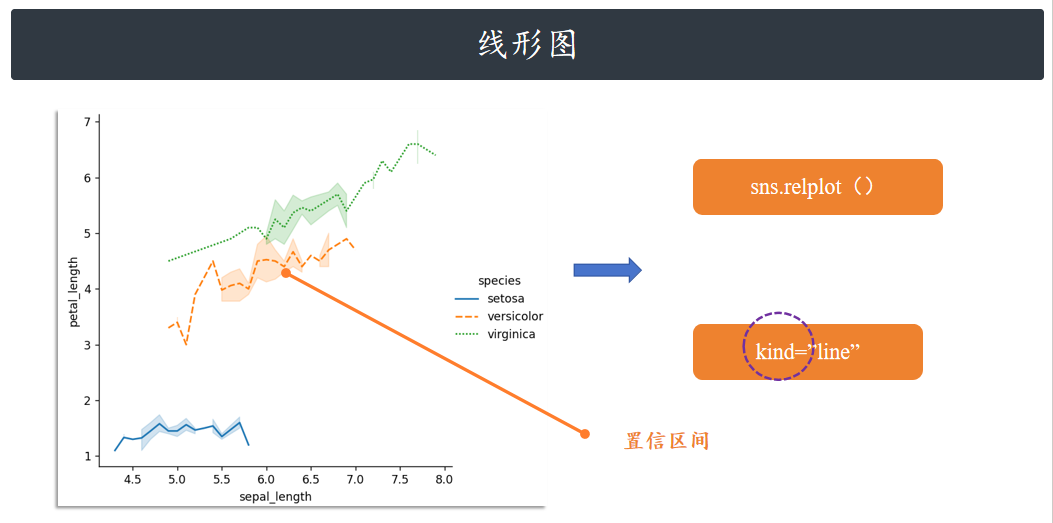
API 层级:Axes-level 和 Figure-level
想快速出图、少写代码?用 Figure-level 的 relplot(通过 kind 切换散点 / 折线)。想精细控制图表
(比如多子图布局、复杂样式)?用 Axes-level 的 scatterplot 或 lineplot,搭配 Matplotlib 更灵
活。
上方 relplot 绘制的图也可以使用 lineplot 函数绘制,只要取消 relplot 中的 kind 参数即可。
sns.lineplot(x="sepal_length", y="petal_length", hue="species", style="species", data=iris)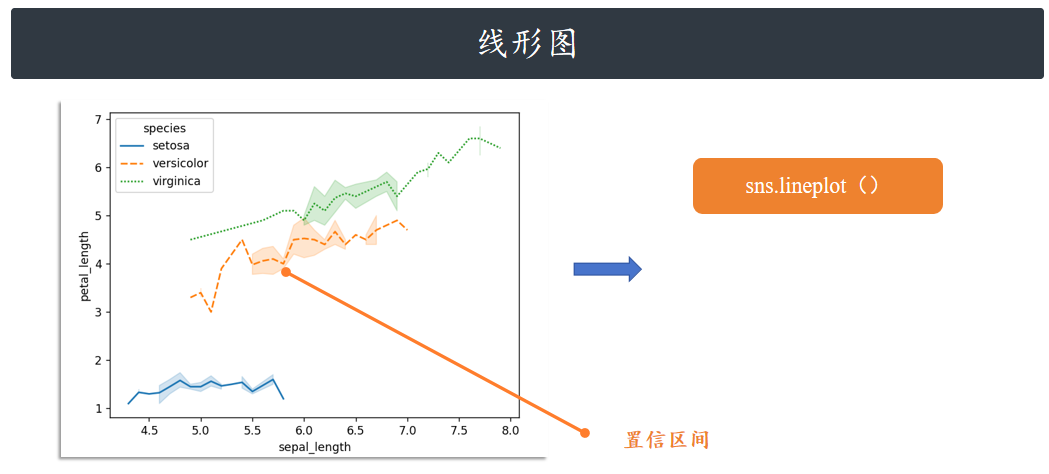
类别图
与关联图相似,类别图的 Figure-level 接口是 catplot,其为 categorical plots 的缩写。而 catplot 实际上是如下 Axes-level 绘图 API 的集合:
| API层级 | 函数 | 介绍 |
|---|---|---|
| Figure-level | catplot | |
| Axes-level | stripplot() (kind=”strip”) swarmplot() (kind=”swarm”) | 分类散点图 |
| boxplot() (kind=”box”) boxenplot() (kind=”boxen”) violinplot() (kind=”violin”) | 分类分布图 | |
| pointplot() (kind=”point”) barplot() (kind=”bar”) countplot() (kind=”count”) | 分类估计图 |
散点图 strip / swarm
下面,我们看一下 catplot 绘图效果。该方法默认是绘制 kind="strip" 散点图。
sns.catplot(x="sepal_length", y="species", data=iris)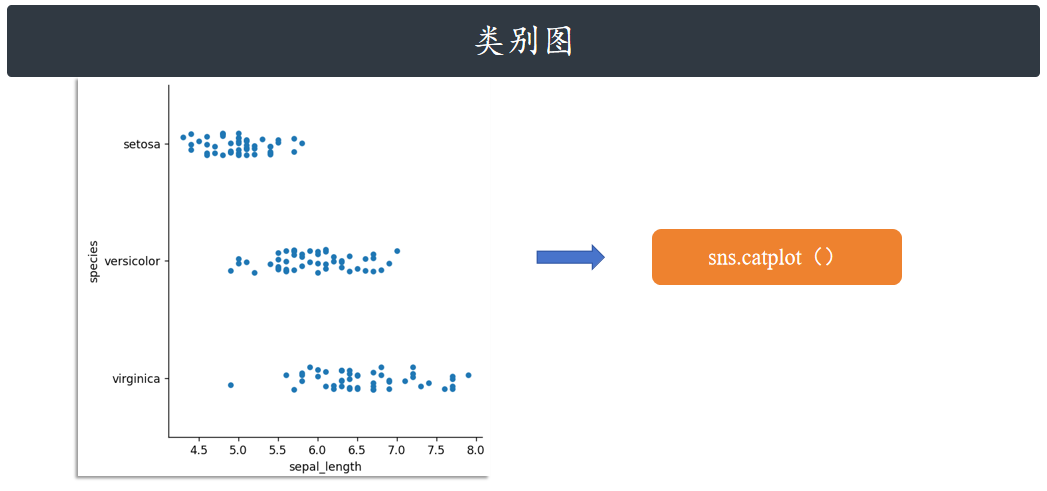
kind="swarm" 可以让散点按照 beeswarm 的方式防止重叠,可以更好地观测数据分布。
sns.catplot(x="sepal_length", y="species", kind="swarm", data=iris)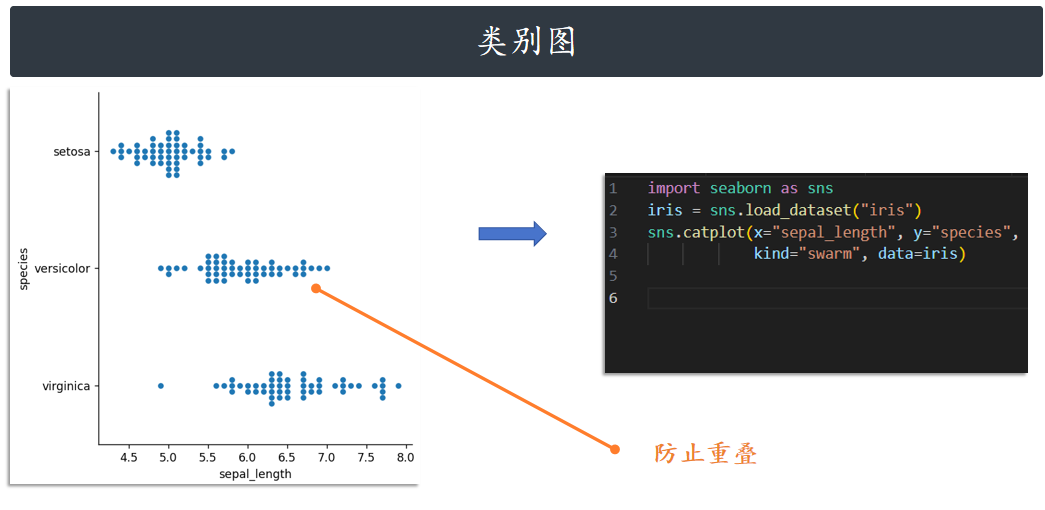
同理,hue=参数可以给图像引入另一个维度,由于 iris 数据集只有一个类别列,我们这里就不再添
加 hue=参数了。如果一个数据集有多个类别,hue=参数就可以让数据点有更好的区分。
箱线图 box
接下来,我们依次尝试其他几种图形的绘制效果。绘制箱线图:
# 导入相关库
import matplotlib.pyplot as plt
import seaborn as sns
import warnings
warnings.filterwarnings('ignore')
# 设置主题,重点修改palette参数更换配色
sns.set_theme(context='notebook',style='whitegrid',palette='Set2', # 可替换为'Pastel1'、'husl'、'coolwarm'等font='sans-serif',font_scale=1,color_codes=False
)
# 加载数据
iris = sns.load_dataset("iris")
# 绘制箱线图,通过palette参数单独设置当前图表配色(优先级高于全局设置)
g = sns.catplot(x="sepal_length",y="species",kind="box",data=iris,palette='Pastel1' # 此处配色会覆盖全局的palette设置
)
# 去除网格线
for ax in g.axes.flat:ax.grid(False)
plt.show()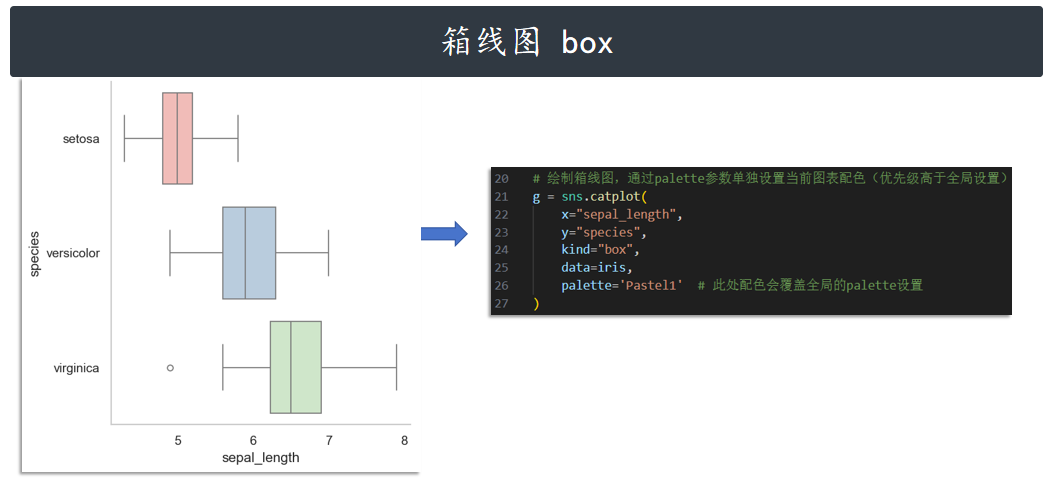
增强箱线图 boxen
g = sns.catplot(x="sepal_length",y="species",kind="boxen",data=iris,palette='Pastel1' # 此处配色会覆盖全局的palette设置
)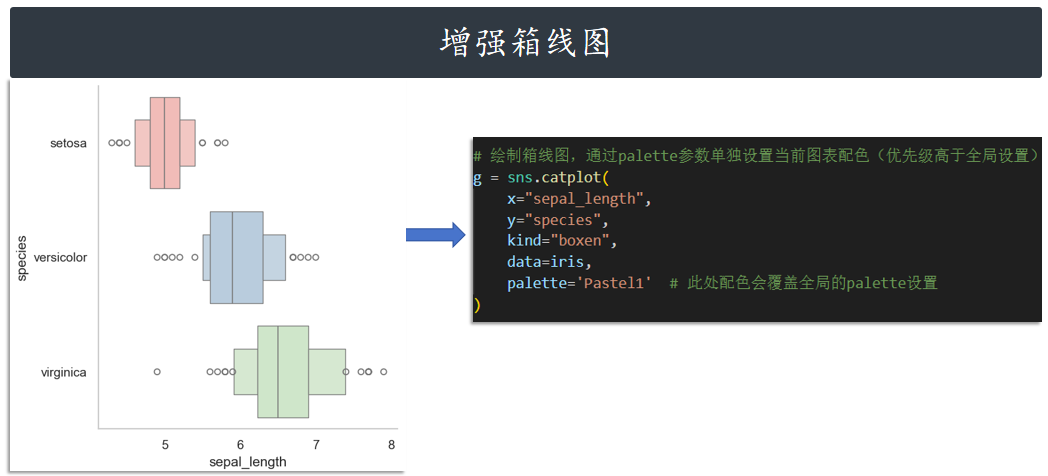
小提琴图 violin
# 绘制箱线图
g = sns.catplot(x="sepal_length",y="species",kind="violin",data=iris,palette='Pastel1'
)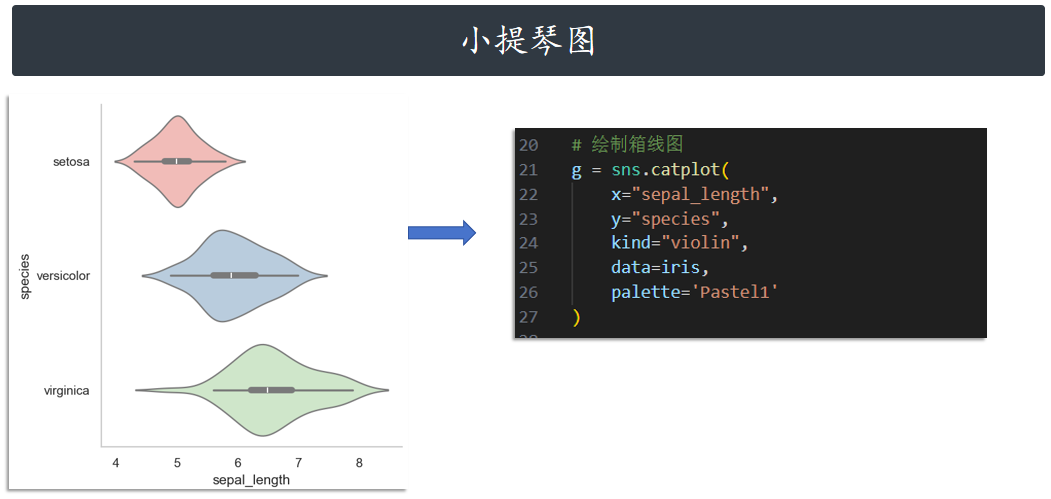
点线图 point
g = sns.catplot(x="sepal_length",y="species",kind="point",data=iris,palette='Pastel1'
)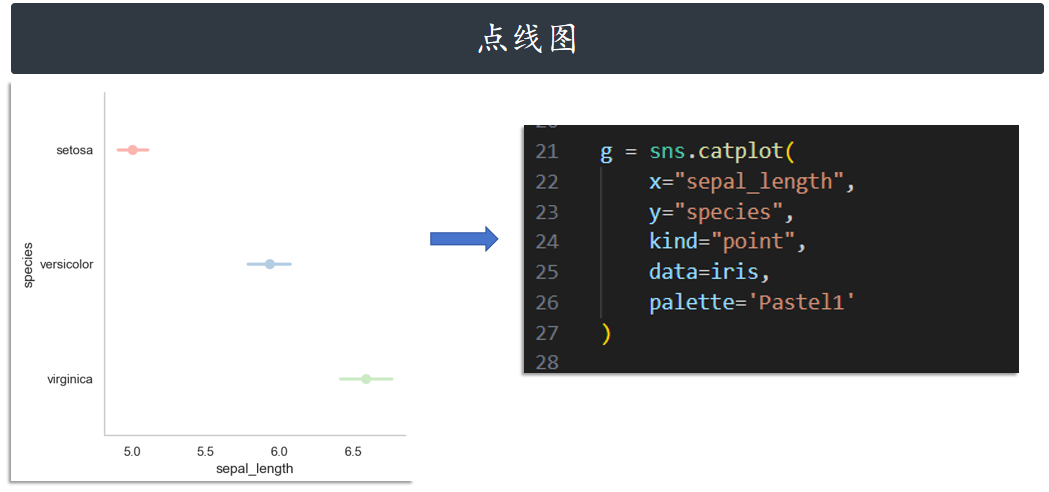
条形图 bar
g = sns.catplot(x="sepal_length",y="species",kind="bar",data=iris,palette='Pastel1'
)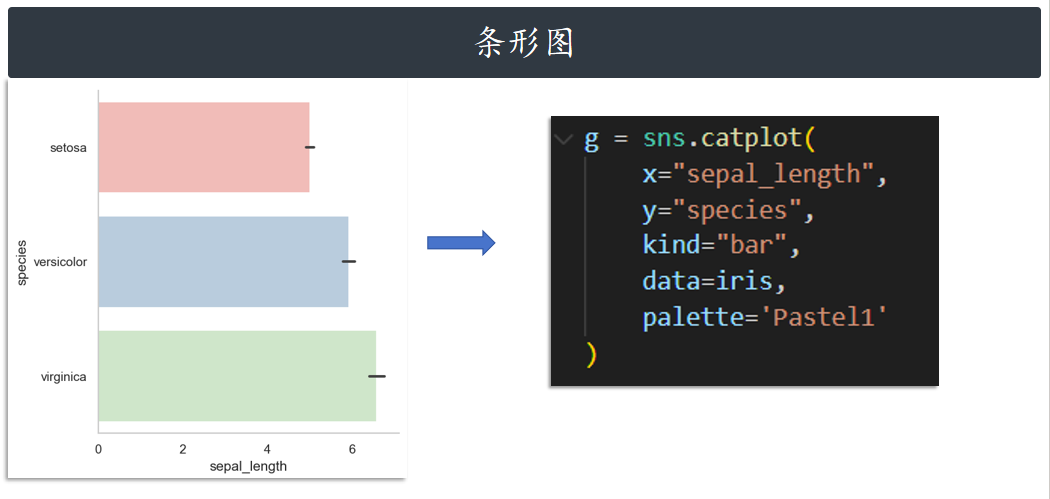
计数条形图 count
g = sns.catplot(x="species",kind="count",data=iris,palette='Pastel1'
)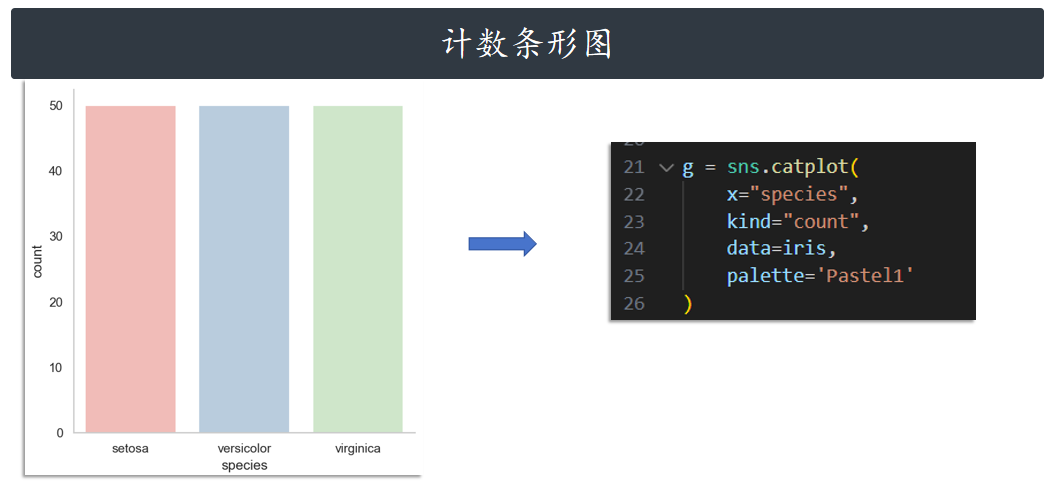
分布图
分布图主要是用于可视化变量的分布情况,一般分为单变量分布和多变量分布(多指二元变
量)。Seaborn 提供的分布图绘制方法一般有这几个:distplot、kdeplot、jointplot、pairplot。接
下来,我们依次来看一下这些绘图方法的使用。
| API层级 | 函数 | 介绍 |
|---|---|---|
| Axes-level | distplot | 绘制直方图并拟合核密度估计图 |
| Axes-level | kdeplot | 专门用于绘制核密度估计图 |
| Axes-level | jointplot | 支持 kind= 参数指定绘制出不同样式的分布图 |
| Axes-level | pairplot | 一次性将数据集中的特征变量两两对比绘图 |
单变量分布图 distplot
Seaborn 快速查看单变量分布的方法是 displot。默认情况下,该方法将绘制直方图并拟合核密度
估计图。
# 导入相关库
import matplotlib.pyplot as plt
import seaborn as sns
import matplotlib.font_manager as fm
import warnings
warnings.filterwarnings('ignore')
# 强制设置中文字体(尝试多种常见字体,确保兼容性)
try:# 尝试加载系统中的中文字体font_names = ["SimHei", "WenQuanYi Micro Hei", "Heiti TC", "Microsoft YaHei"]font = Nonefor name in font_names:try:font = fm.FontProperties(family=name)# 测试字体是否可用if font.get_name() in font_names:breakexcept:continue# 全局字体设置plt.rcParams["font.family"] = [font.get_name()] if font else ["sans-serif"]
except:# fallback方案:使用支持中文的默认配置plt.rcParams["font.family"] = ["Arial Unicode MS", "sans-serif"]
# 确保负号正确显示
plt.rcParams['axes.unicode_minus'] = False
# 设置主题(不指定字体,使用全局设置)
sns.set_theme(context='notebook',style='whitegrid',palette='Set2',font_scale=1,color_codes=False
)
# 加载数据
iris = sns.load_dataset("iris")
# 绘制直方图并拟合核密度估计图
g = sns.displot(data=iris,x="sepal_length",hue="species",kind="hist",kde=True,bins=15,palette='Pastel1'
)
# 去除网格线
for ax in g.axes.flat:ax.grid(False)# 为坐标轴标签单独设置字体(确保中文显示)ax.set_xlabel("花萼长度 (cm)", fontproperties=font, fontsize=12)ax.set_ylabel("频数", fontproperties=font, fontsize=12)
# 为标题单独设置字体
plt.title("不同种类鸢尾花的花萼长度分布", fontproperties=font, fontsize=14)
plt.show()# 使用displot函数,kind="hist"指定直方图,kde=True添加核密度曲线
g = sns.displot(data=iris,x="sepal_length", # 选择要展示分布的变量(这里用花萼长度)hue="species", # 按鸢尾花种类分组显示kind="hist", # 图表类型为直方图kde=True, # 添加核密度估计曲线bins=15, # 直方图的分箱数量,控制精度palette='Pastel1' # 配色方案
)核密度估计图 kdeplot
当然,kdeplot 可以专门用于绘制核密度估计图,其效果和 distplot(hist=False) 一致,但 kdeplot 拥有更多的自定义设置。
# 导入相关库
import matplotlib.pyplot as plt
import seaborn as sns
import matplotlib.font_manager as fm
import warnings
warnings.filterwarnings('ignore')
# 1. 手动指定中文字体文件(关键步骤,根据系统修改)
# Windows: "C:/Windows/Fonts/simhei.ttf"(黑体)
# macOS: "/System/Library/Fonts/PingFang.ttc"(苹方)
# Linux: "/usr/share/fonts/opentype/noto/NotoSansCJK-Regular.ttc"
font_path = "C:/Windows/Fonts/simhei.ttf"
# 加载字体并创建字体属性对象
try:chinese_font = fm.FontProperties(fname=font_path)
except FileNotFoundError:# 如果指定字体不存在,使用系统默认中文字体chinese_font = fm.FontProperties(family=["SimHei", "WenQuanYi Micro Hei", "Heiti TC"])
# 2. 全局字体配置
plt.rcParams.update({"font.family": chinese_font.get_name(),"axes.unicode_minus": False, # 解决负号显示问题
})
# 3. 设置Seaborn主题
sns.set_theme(context='notebook',style='white',palette='Set2',font_scale=1,color_codes=False
)
# 4. 加载数据
iris = sns.load_dataset("iris")
# 5. 创建画布并绘制核密度图
plt.figure(figsize=(10, 6))
for species in iris["species"].unique():subset = iris[iris["species"] == species]sns.kdeplot(data=subset,x="sepal_length",label=species,fill=True,alpha=0.3,linewidth=2)
# 6. 添加标题和轴标签(明确指定字体)
plt.title("不同种类鸢尾花的花萼长度核密度分布", fontproperties=chinese_font, fontsize=14)
plt.xlabel("花萼长度 (cm)", fontproperties=chinese_font, fontsize=12)
plt.ylabel("密度", fontproperties=chinese_font, fontsize=12)
# 7. 单独设置图例(重点解决"鸢尾花种类"标题显示问题)
legend = plt.legend(title="鸢尾花种类", # 图例标题prop=chinese_font, # 图例内容字体title_fontproperties=chinese_font # 图例标题字体(关键设置)
)
plt.grid(axis="y", alpha=0.2)
plt.show()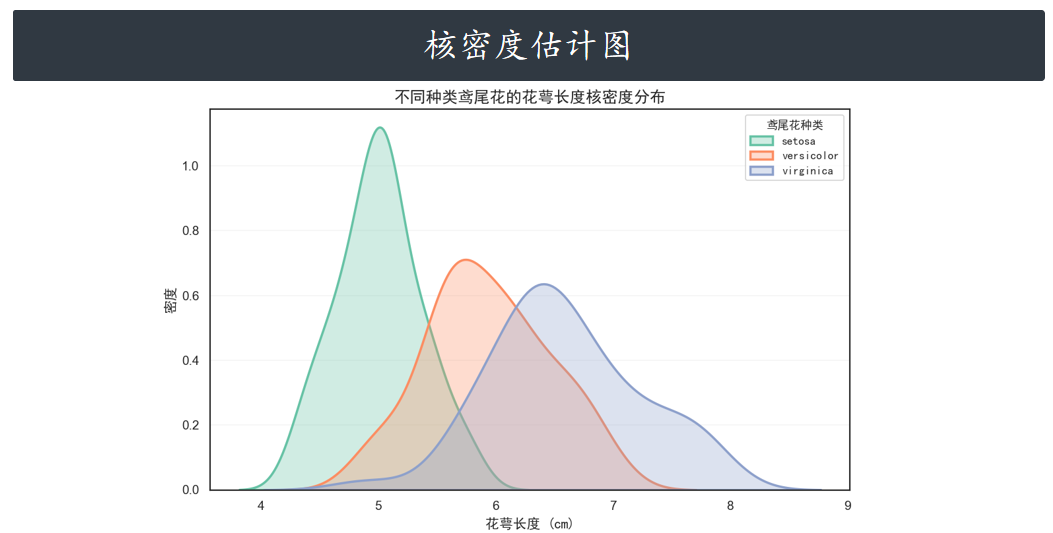
二元变量分布图 jointplot
jointplot 主要是用于绘制二元变量分布图。例如,我们探寻 sepal_length 和 sepal_width 二元特征变量之间的关系。
# 导入相关库
import matplotlib.pyplot as plt
import seaborn as sns
import matplotlib.font_manager as fm
import warnings
warnings.filterwarnings('ignore')
# 中文显示设置(指定字体文件路径)
font_path = "C:/Windows/Fonts/simhei.ttf" # Windows系统
# font_path = "/System/Library/Fonts/PingFang.ttc" # macOS系统
chinese_font = fm.FontProperties(fname=font_path)
# 全局字体配置
plt.rcParams.update({"font.family": chinese_font.get_name(),"axes.unicode_minus": False
})
# 加载数据
iris = sns.load_dataset("iris")
# 绘制二元变量分布图
g = sns.jointplot(data=iris,x="sepal_length", # x轴:花萼长度y="petal_length", # y轴:花瓣长度hue="species", # 按种类分组kind="scatter", # 中心为散点图palette="Set2", # 配色方案height=8 # 图表大小
)
# 调整标题位置和布局(解决显示不完全问题)
# 1. 增加顶部边距,为标题留出空间
plt.subplots_adjust(top=0.9)
# 2. 设置标题,y参数控制与图表的距离(值越小越靠下)
g.fig.suptitle("花萼长度与花瓣长度的关系分布",fontproperties=chinese_font,y=0.98, # 调整此值(0-1之间)控制标题位置fontsize=14
)
# 设置轴标签
g.ax_joint.set_xlabel("花萼长度 (cm)", fontproperties=chinese_font, fontsize=12)
g.ax_joint.set_ylabel("花瓣长度 (cm)", fontproperties=chinese_font, fontsize=12)
# 设置图例字体
plt.legend(title="鸢尾花种类", prop=chinese_font, title_fontproperties=chinese_font)
plt.show()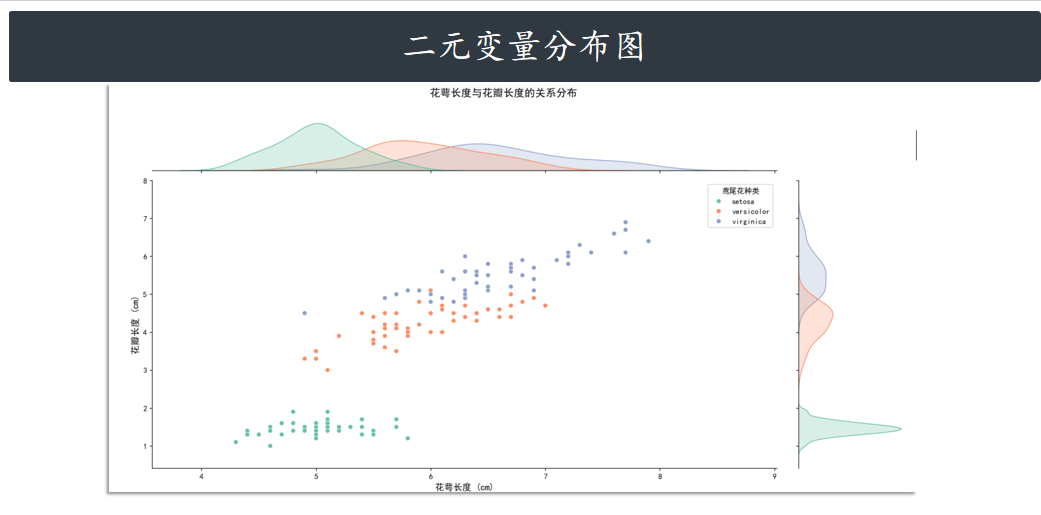
jointplot 并不是一个 Figure-level 接口,但其支持 kind= 参数 指定绘制出不同样式的分布图。
例如,绘制出核密度估计对比图 kde
# 导入相关库
import matplotlib.pyplot as plt
import seaborn as sns
import matplotlib.font_manager as fm
import warnings
warnings.filterwarnings('ignore')
# 中文显示设置(指定字体文件路径)
font_path = "C:/Windows/Fonts/simhei.ttf" # Windows系统
# font_path = "/System/Library/Fonts/PingFang.ttc" # macOS系统
chinese_font = fm.FontProperties(fname=font_path)
# 全局字体配置
plt.rcParams.update({"font.family": chinese_font.get_name(),"axes.unicode_minus": False
})
# 加载数据
iris = sns.load_dataset("iris")
# 绘制核密度联合分布图(kind="kde")
g = sns.jointplot(x="sepal_length", # x轴:花萼长度y="sepal_width", # y轴:花萼宽度data=iris,kind="kde", # 图表类型:核密度图(展示数据密度分布)cmap="viridis", # 颜色映射(核密度图常用渐变色系)height=8 # 图表大小
)
# 调整布局,确保标题完整显示
plt.subplots_adjust(top=0.9) # 增加顶部边距
# 设置标题
g.fig.suptitle("花萼长度与花萼宽度的核密度分布",fontproperties=chinese_font,y=0.98, # 标题位置(靠近顶部但不超出)fontsize=14
)
# 设置轴标签
g.ax_joint.set_xlabel("花萼长度 (cm)", fontproperties=chinese_font, fontsize=12)
g.ax_joint.set_ylabel("花萼宽度 (cm)", fontproperties=chinese_font, fontsize=12)
plt.show()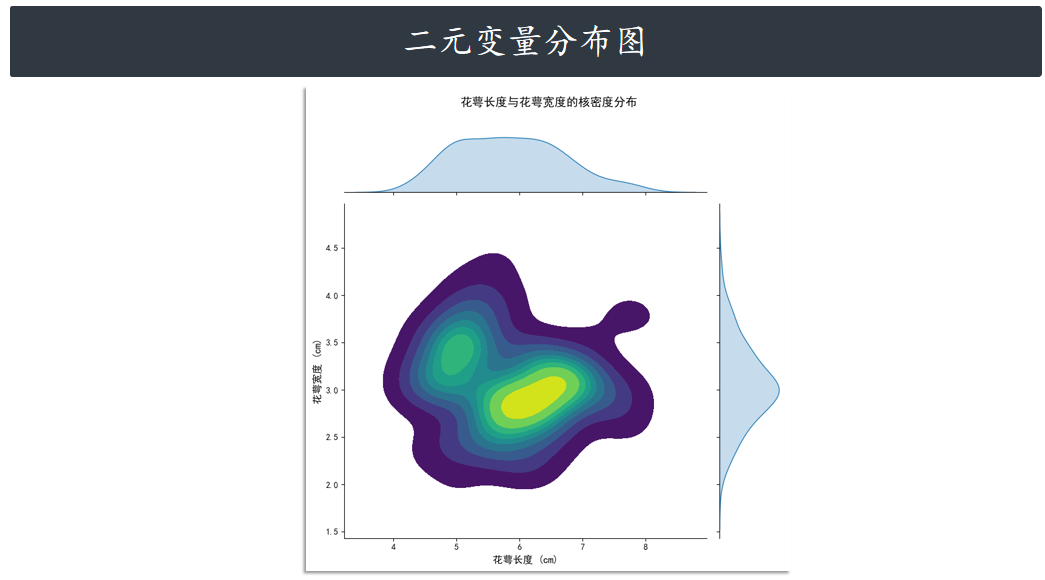
绘制六边形计数图 hex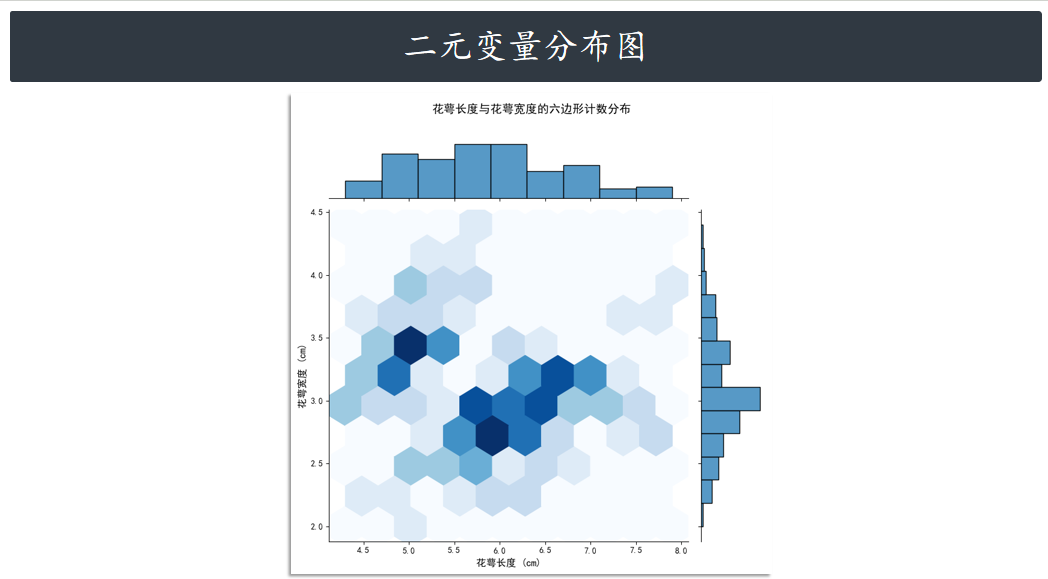
绘制回归拟合图
# 导入相关库
import matplotlib.pyplot as plt
import seaborn as sns
import matplotlib.font_manager as fm
import warnings
warnings.filterwarnings('ignore')
# 中文显示设置(指定字体文件路径)
# 假设字体路径已设置
font_path = "C:/Windows/Fonts/simhei.ttf"
chinese_font = fm.FontProperties(fname=font_path)
# 全局字体配置
plt.rcParams.update({"font.family": chinese_font.get_name(),"axes.unicode_minus": False
})
# 加载数据
iris = sns.load_dataset("iris")
# 绘制回归拟合联合分布图(kind="reg")
g = sns.jointplot(x="sepal_length", # x轴:花萼长度y="sepal_width", # y轴:花萼宽度data=iris,kind="reg", # 核心参数:指定为回归拟合图color="g", # 设置散点和回归线的颜色为绿色scatter_kws={'alpha': 0.6}, # 设置散点图透明度,避免重叠line_kws={'color': 'red', 'linewidth': 2}, # 设置回归线的颜色和粗细height=8 # 图表大小
)
# 调整布局,确保标题完整显示
plt.subplots_adjust(top=0.9)
# 设置标题
g.fig.suptitle("花萼长度与花萼宽度的回归拟合",fontproperties=chinese_font,y=0.98,fontsize=14
)
# 设置轴标签
g.ax_joint.set_xlabel("花萼长度 (cm)", fontproperties=chinese_font, fontsize=12)
g.ax_joint.set_ylabel("花萼宽度 (cm)", fontproperties=chinese_font, fontsize=12)
plt.show()变量两两对比图 pairplot
最后要介绍的 pairplot 更加强大,其支持一次性将数据集中的特征变量两两对比绘图。默认情况
下,对角线上是单变量分布图,而其他则是二元变量分布图。
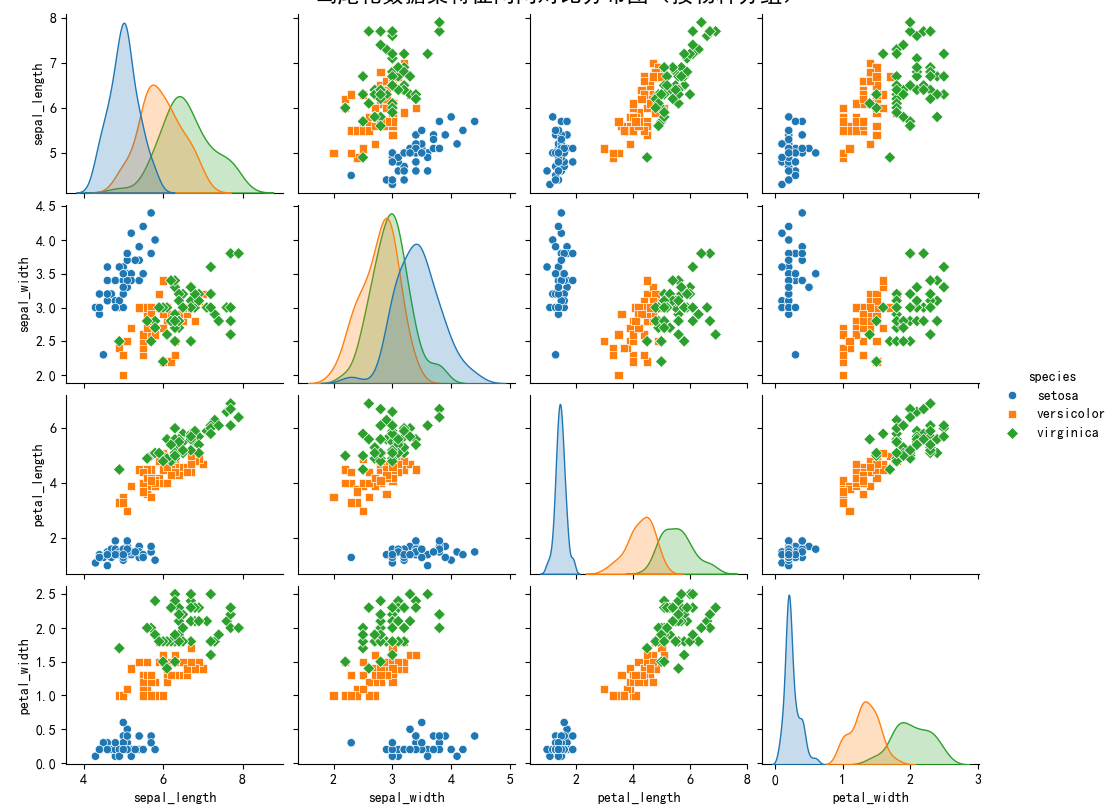
回归图
接下来,我们继续介绍回归图,回归图的绘制函数主要有:lmplot 和 regplot。
| API层级 | 函数 | 介绍 |
|---|---|---|
| Axes-level | regplot | 自动完成线性回归拟合 |
| Axes-level | lmplot | 支持引入第三维度进行对比 |
regplot
regplot 绘制回归图时,只需要指定自变量和因变量即可,regplot 会自动完成线性回归拟合。
# 导入相关库
import matplotlib.pyplot as plt
import seaborn as sns
import matplotlib.font_manager as fm
import warnings
warnings.filterwarnings('ignore')
# 中文显示设置(指定字体文件路径)
# 假设字体路径已设置
font_path = "C:/Windows/Fonts/simhei.ttf"
chinese_font = fm.FontProperties(fname=font_path)
# 全局字体配置
plt.rcParams.update({"font.family": chinese_font.get_name(),"axes.unicode_minus": False
})
# 加载数据
iris = sns.load_dataset("iris")
# 创建一个 matplotlib Figure 和 Axes
plt.figure(figsize=(10, 6))
# 使用 regplot 绘制线性回归拟合图
sns.regplot(x="sepal_length", # 自变量(花萼长度)y="sepal_width", # 因变量(花萼宽度)data=iris,color="darkorange", # 设置散点和回归线的颜色scatter_kws={'alpha': 0.7}, # 设置散点透明度line_kws={'color': 'black', 'linewidth': 2} # 设置回归线的颜色和粗细
)
# 设置标题和轴标签
plt.title("花萼长度与花萼宽度的线性回归拟合图",fontproperties=chinese_font,fontsize=16
)
plt.xlabel("花萼长度 (cm)", fontproperties=chinese_font, fontsize=12)
plt.ylabel("花萼宽度 (cm)", fontproperties=chinese_font, fontsize=12)
# 显示网格线,增强可读性
#plt.grid(True, linestyle='--', alpha=0.6)
plt.show()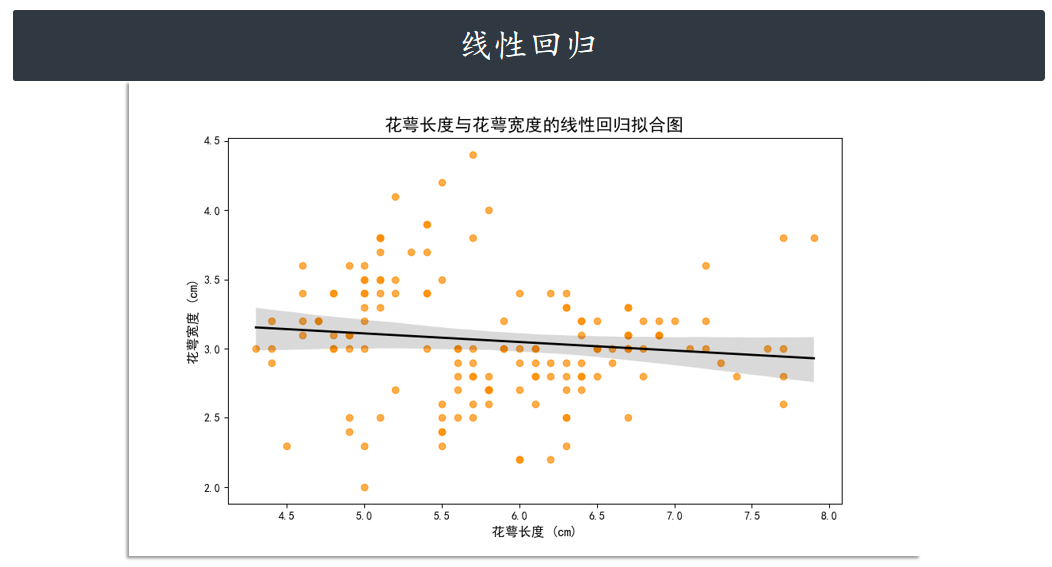
lmplot
lmplot 同样是用于绘制回归图,但 lmplot 支持引入第三维度进行对比,例如我们设
置 hue="species"。
# 导入相关库
import matplotlib.pyplot as plt
import seaborn as sns
import matplotlib.font_manager as fm
import warnings
warnings.filterwarnings('ignore')
# 中文显示设置(指定字体文件路径)
# 假设字体路径已设置
font_path = "C:/Windows/Fonts/simhei.ttf"
chinese_font = fm.FontProperties(fname=font_path)
# 全局字体配置
plt.rcParams.update({"font.family": chinese_font.get_name(),"axes.unicode_minus": False
})
# 加载数据
iris = sns.load_dataset("iris")
# 使用 lmplot 绘制分组线性回归拟合图
g = sns.lmplot(x="sepal_length", # 自变量y="sepal_width", # 因变量data=iris,hue="species", # 按物种分组,计算独立的回归线height=7, # 图表高度aspect=1.2, # 宽高比palette="deep"
)
# 【关键步骤】调整子图布局,增加顶部边距
# 默认的 top 值接近 0.9,我们将其增加到 0.94 或更高,以确保标题有足够空间
g.fig.subplots_adjust(top=0.94)
# 调整图表标题
g.fig.suptitle("花萼长度与花萼宽度的分组线性回归拟合图",fontproperties=chinese_font,y=1.0, # y=1.0 意味着将标题放在 figure 的顶部边缘fontsize=16
)
# 设置轴标签
g.set_axis_labels("花萼长度 (cm)", "花萼宽度 (cm)", fontproperties=chinese_font, fontsize=12)
plt.show()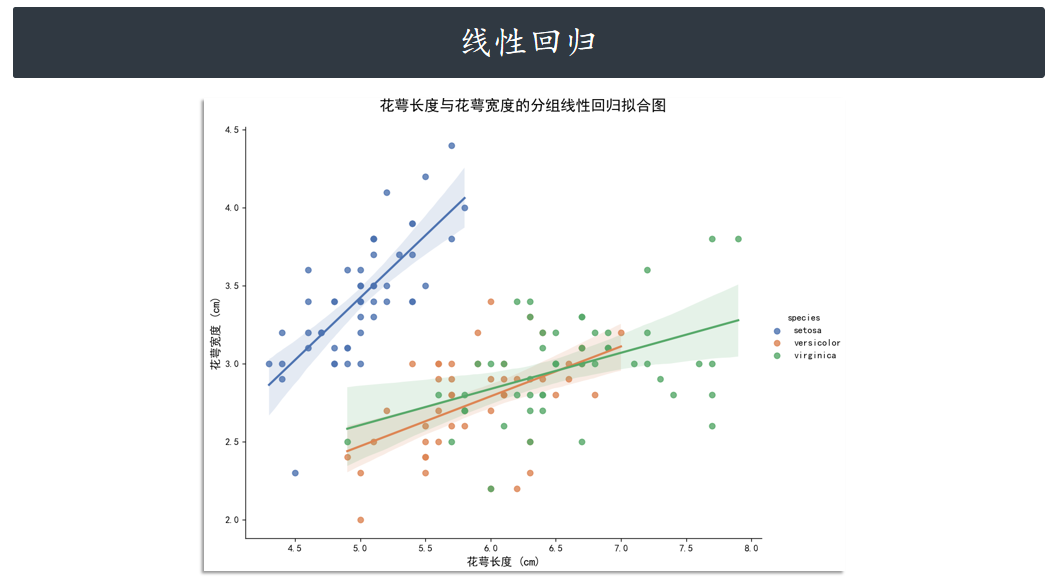
矩阵图
矩阵图中最常用的就只有 2 个,分别是:heatmap 和 clustermap。
| API层级 | 函数 | 介绍 |
|---|---|---|
| Axes-level | heatmap | 绘制热力图 |
| Axes-level | clustermap | 层次聚类结构图 |
热力图 heatmap
意如其名,heatmap 主要用于绘制热力图。热力图在某些场景下非常实用,例如绘制出变量相关
性系数热力图。
# 导入相关库
import matplotlib.pyplot as plt
import seaborn as sns
import matplotlib.font_manager as fm
import warnings
import pandas as pd # 需要用到 pandas 来计算相关系数
warnings.filterwarnings('ignore')
# 中文显示设置(指定字体文件路径)
# 假设字体路径已设置
font_path = "C:/Windows/Fonts/simhei.ttf"
chinese_font = fm.FontProperties(fname=font_path)
# 全局字体配置
plt.rcParams.update({"font.family": chinese_font.get_name(),"axes.unicode_minus": False
})
# 加载数据
iris = sns.load_dataset("iris")
# 1. 计算相关性矩阵
# drop("species", axis=1) 排除非数值的 "species" 列
correlation_matrix = iris.drop("species", axis=1).corr()
# 2. 创建 Figure 和 Axes
plt.figure(figsize=(8, 7))
# 3. 绘制热力图
sns.heatmap(correlation_matrix,annot=True, # 在单元格内显示相关性数值cmap="coolwarm", # 使用 coolwarm 颜色映射,方便区分正负相关fmt=".2f", # 将数值格式化为两位小数linewidths=.5, # 单元格之间的线条宽度linecolor='black', # 单元格边框颜色cbar=True # 显示颜色条
)
# 设置标题
plt.title("鸢尾花数据集特征相关性系数热力图",fontproperties=chinese_font,fontsize=16,pad=20
)
plt.show()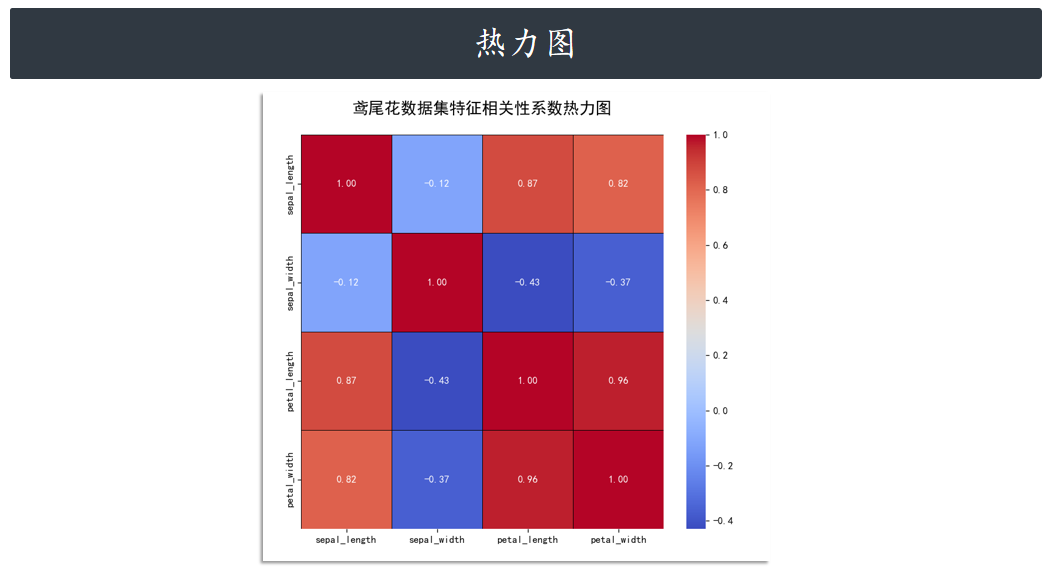
层次聚类结构图clustermap
除此之外,clustermap 支持绘制层次聚类结构图。如下所示,我们先去掉原数据集中最后一个目
标列,传入特征数据即可。
# 导入相关库
import matplotlib.pyplot as plt
import seaborn as sns
import matplotlib.font_manager as fm
import warnings
import pandas as pd
warnings.filterwarnings('ignore')
# 字体设置保持不变
font_path = "C:/Windows/Fonts/simhei.ttf"
chinese_font = fm.FontProperties(fname=font_path)
plt.rcParams.update({"font.family": chinese_font.get_name(), "axes.unicode_minus": False})
# 加载数据并移除非数值列
iris = sns.load_dataset("iris")
iris_features = iris.drop("species", axis=1)
# 绘制层次聚类结构图
g = sns.clustermap(iris_features,cmap="rocket", # 假设我们使用 'rocket' 配色z_score=0, # 沿列标准化figsize=(8, 10), # 增加 figsize 的高度(例如到 10)也有帮助linewidths=0.5,linecolor='white'
)
# 【核心修改 1】设置标题并使用稍高的 y 值 (1.02)
plt.suptitle("鸢尾花特征数据的层次聚类结构图 (rocket 配色,超长标题测试)",fontproperties=chinese_font,y=1.02, # 将标题设置在 Figure 顶部边缘之上fontsize=16
)
# 【核心修改 2】增加顶部边距,确保标题不被截断
# 增加 top 参数的值(例如 0.9 或 0.95),将图表主体向下推
plt.subplots_adjust(top=0.9)
plt.show()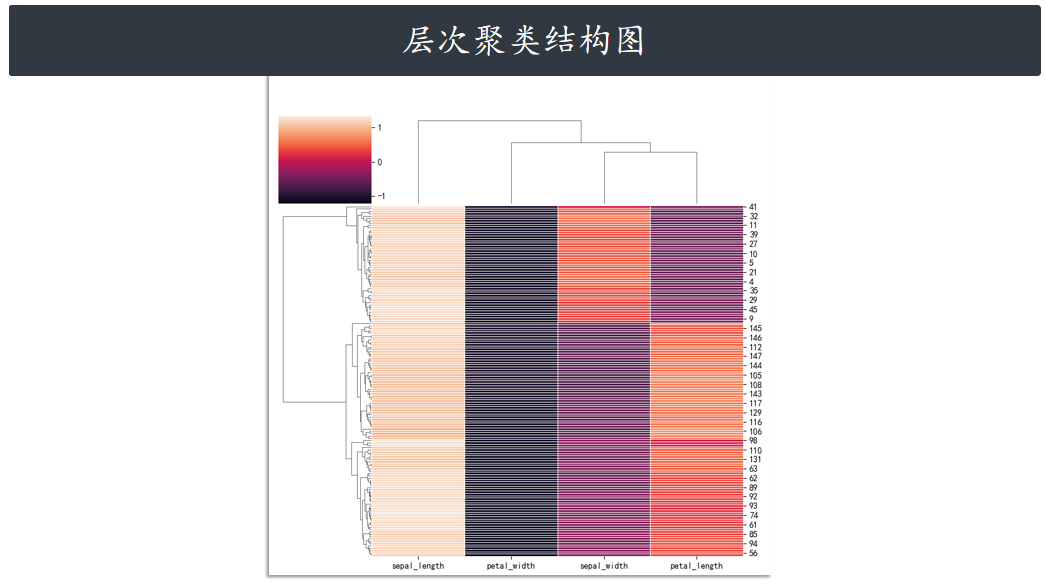
参考:系列教程

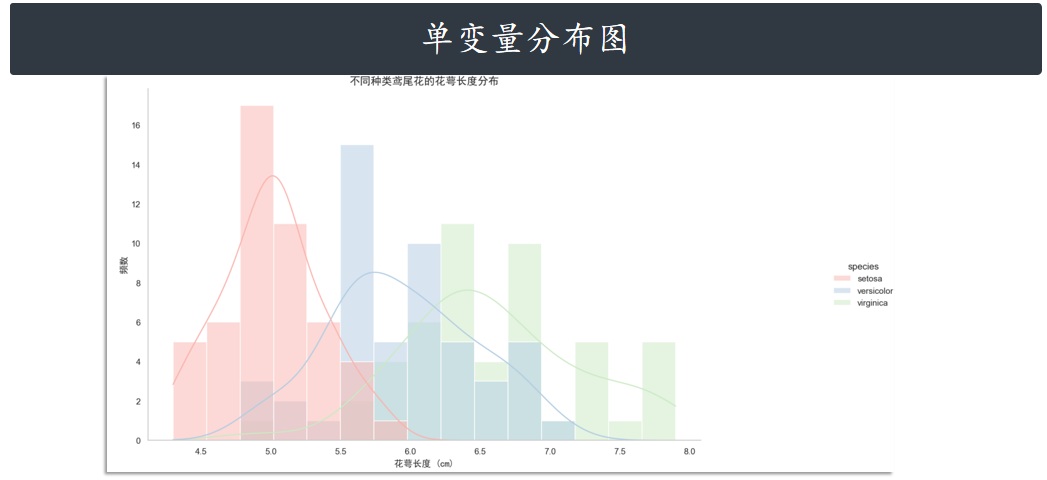
)


















